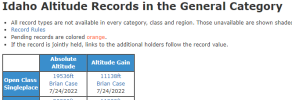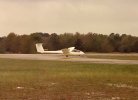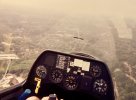Aceman
Pre-Flight
- Joined
- Jan 17, 2024
- Messages
- 72
- Display Name
Display name:
Aceman
All,
I'm about to head out to pilot training school for glider pilots. I've already taken the written exam and I've trained in powered aircraft before (~30hrs). I'm in love with the glider because it reminds me of a fighter plane and the controls mimic the stick-n-rudder that I prefer to own when I finally do own my a glider.
During the course of my studying and many small flights with a glider/airplane and the pilots I do talk to -- I've realized that flying a glider is much more advanced than flying a powered airplane. There are much more things to worry about every second you are in flight. There are so many decisions that constantly have to be updated while flying a glider vs. a powered airplane. Weather is way more crucial in a glider than a normal plane -- not to mention landings. Furthermore energy management while in a thermal and climbing is paramount to being successful in cross-country scenarios.
Why is it that the FAA doesn't see it that way. Getting an endorsement for gliders on your license should be the other way around. People that have a glider's license should be very easy to get a private pilot endorsement since the glider pilot will be a better pilot overall. Understanding engines is literally the only variable that one would need to study extra for powered aircraft compared to all the other extra information you'd need to be a good glider pilot(i.e. weather, planning, weight and balance, aircraft performance, etc..)
Thoughts?
I'm about to head out to pilot training school for glider pilots. I've already taken the written exam and I've trained in powered aircraft before (~30hrs). I'm in love with the glider because it reminds me of a fighter plane and the controls mimic the stick-n-rudder that I prefer to own when I finally do own my a glider.
During the course of my studying and many small flights with a glider/airplane and the pilots I do talk to -- I've realized that flying a glider is much more advanced than flying a powered airplane. There are much more things to worry about every second you are in flight. There are so many decisions that constantly have to be updated while flying a glider vs. a powered airplane. Weather is way more crucial in a glider than a normal plane -- not to mention landings. Furthermore energy management while in a thermal and climbing is paramount to being successful in cross-country scenarios.
Why is it that the FAA doesn't see it that way. Getting an endorsement for gliders on your license should be the other way around. People that have a glider's license should be very easy to get a private pilot endorsement since the glider pilot will be a better pilot overall. Understanding engines is literally the only variable that one would need to study extra for powered aircraft compared to all the other extra information you'd need to be a good glider pilot(i.e. weather, planning, weight and balance, aircraft performance, etc..)
Thoughts?
Last edited:





